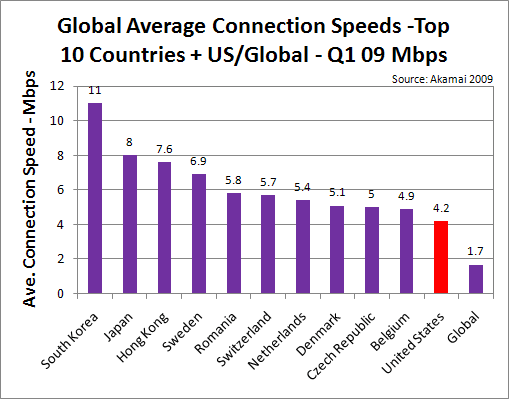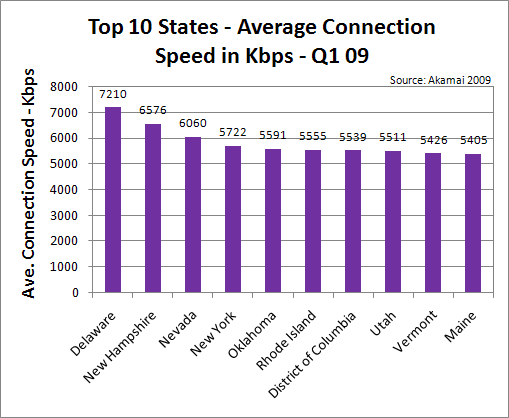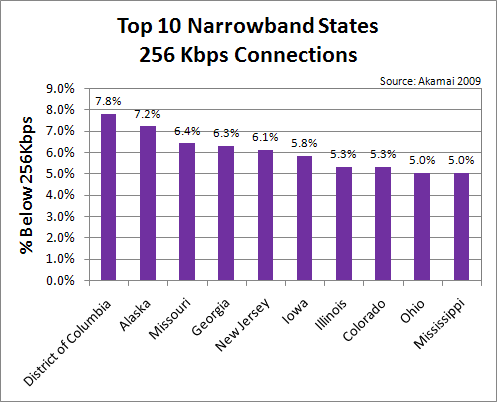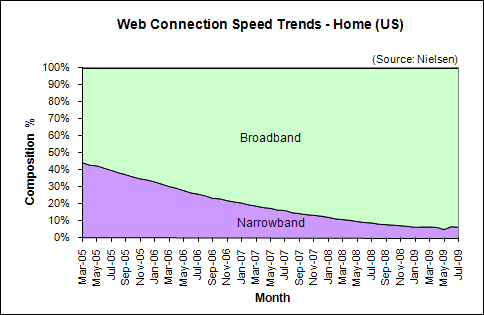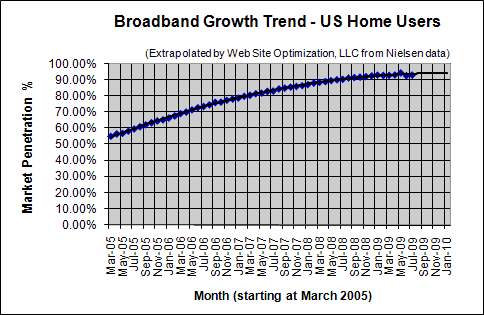The US came in 18th among all countries surveyed in average connection speed, growing at about half the worldwide average increase over the past year. Within the US, Delaware had the fastest connection speed among the 50 states, averaging more than 7Mb per second. Washington and Georgia top the list in Internet penetration per capita, according to a recent survey by Akamai. Worldwide, South Korea continues to lead all countries in average connection speed at 11Mbps. Meanwhile, broadband penetration among active Internet users grew to 93.3% in July 2009.
The Fastest Broadband Countries
As broadband adoption continues to grow, the general trend is towards higher broadband connection speeds. Globally the average connection speed increased over the last year by 29% to 1.7Mbps (see Figure 1). South Korea continues to lead all countries in average connection speed at 11Mbps, but due to its high penetration rate showed the only negative growth rate in connection speed over the past year of -1.1%. Japan at 8Mbps was second to South Korea, followed by Hong Kong (7.6Mbps), Sweden (6.9Mbps) and Romania at 5.8Mbps. The US came in 18th overall in average connection speed at 4.2Mbps, above the global average of 1.7Mpbs but more than 2.6 times slower than South Korea. The average US connection speed grew by 15% over the past year, about half the worldwide average increase of 29%.
Figure 1: Top 10 Countries in Average Connection Speed
Source: Akamai
The Fastest Broadband States
The east coast is well represented in the states with the fastest average connection speeds, with 7 out of the top 10 states from the east coast (see Figure 2). Delaware topped the list of United States in average connection speed at 7.2 Mbps, with 97% of its broadband connections above 2Mbps. New Hampshire came in second at 6.6 Mbps, followed by Nevada at 6.1Mbps, New York at 5.7Mbps, and Oklahoma at 5.6Mbps.
Figure 2: Top 10 States in Average Connection Speed
Source: Akamai
Top 10 Narrowband States
In the first quarter of 2009, the District of Columbia topped the list of narrowband states with 7.8% of connections below 256Kbps (see Figure 3). Alaska came in second at 7.2%, followed by Missouri (6.4%), Georgia (6.3%), and New Jersey at 6.1%. Four states (Maryland, Nebraska, North Carolina, and Rhode Island) saw increasing narrowband percentages on a quarter by quarter basis, while all the others showed significant decreases in narrowband percentages.
Figure 3: Top 10 Narrowband States in Average Connection Speed
Source: Akamai
United States Internet Penetration
For tha past three quarters, Akamai has tracked the growth in penetration among Internet users in the United States. Using US Census population estimates and the number of unique IP address from each state that Akamai saw during the first quarter of 2009, they calculated the levels of Internet penetration on a state-by-state basis. The top 10 states are shown in Figure 4. Washington and Georgia lead all states with 0.62 IP addresses per capita.
Figure 4: Top 10 States Internet Penetration
Source: Akamai
Home Connectivity in the US
US broadband penetration grew to 93.31% in July 2009. Dial-up users connecting at 56Kbps or less now make up 6.69% of active Internet users (see Figure 5).
Figure 5: Web Connection Speed Trends – Home Users (US)
Source: Nielsen
Broadband Growth Trends in the US
In July 2009, broadband penetration among active Internet users in US homes grew to 93.31%, up 0.35 percentage points fron 92.96% in June (see Figure 6).
Work Connectivity
As of July 2009, 98.44% of US workers connected to the Internet with broadband, down 0.03 percentage points from 98.47% in June 2009.
Some 1.56% connect at 56Kbps or less (see Figure 7).
Figure 7: Web Connection Speed Trends – Work Users (US)
Source: Nielsen
Further Reading
- Akamai
- The data shown above is derived from Akamai’s “The State of the Internet” report, showing data from the first quarter of 2009. The survey includes data gathered over Akamai’s global server network. Akamai, Q1 2009.
- Nielsen
- Provided the US broadband penetration data for active Internet users for the Bandwidth Report. Starting with our July 2009 broadband survey we have some new more accurate data for you from June and July.

